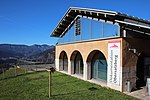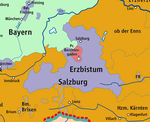General Walker Hotel
The General Walker Hotel was a hotel for US troops after World War II in the mountain (Alpine) retreat of Obersalzberg, Germany. The former Pension Moritz boarding house, boasting opulent accommodations and sweeping views of the Bavarian countryside and Alpine scenery, had been opened in 1878 and renamed Platterhof in 1928. After the Nazi seizure of power, it became a "people's" hostel for visitors to the extended containment area around Hitler's headquarters at the nearby Berghof residence. It was subsequently rebuilt into a luxury hotel for visiting dignitaries and in 1943 was converted into a military hospital.Following World War II, the damaged building was restored as a United States Armed Forces Recreation Center (AFRC), and again renamed after US Army General Walton Walker (1889–1950), killed in action in the Korean War. The complex was demolished in 2001.
Excerpt from the Wikipedia article General Walker Hotel (License: CC BY-SA 3.0, Authors).General Walker Hotel
Salzbergstraße,
Geographical coordinates (GPS) Address Nearby Places Show on map
Geographical coordinates (GPS)
| Latitude | Longitude |
|---|---|
| N 47.6305 ° | E 13.0413 ° |
Address
Salzbergstraße
83471
Bavaria, Germany
Open on Google Maps











